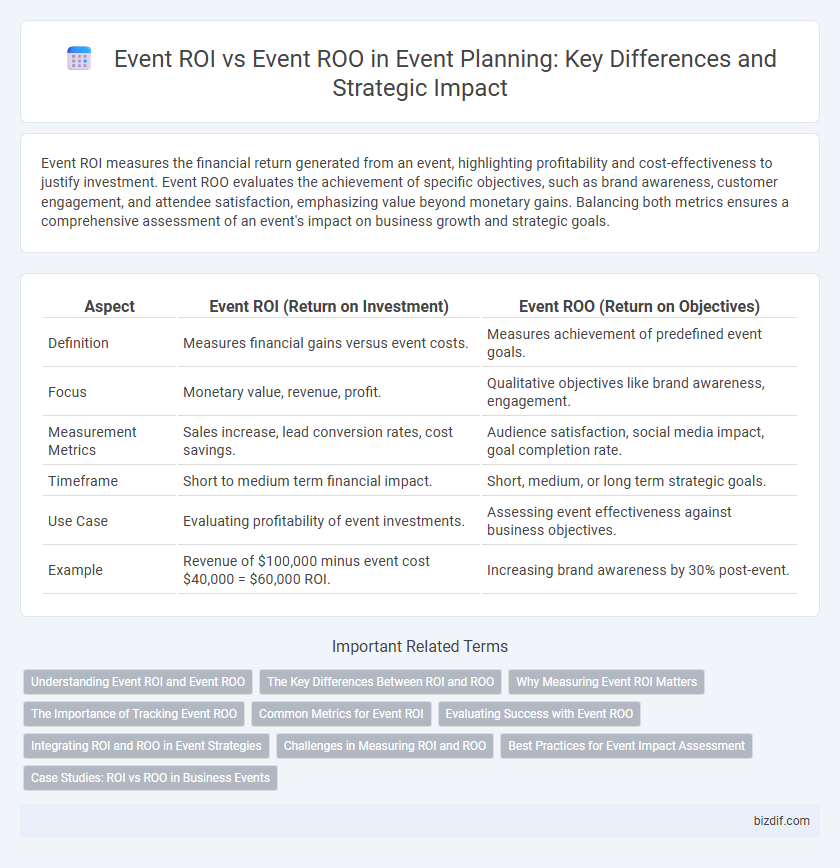Event ROI measures the financial return generated from an event, highlighting profitability and cost-effectiveness to justify investment. Event ROO evaluates the achievement of specific objectives, such as brand awareness, customer engagement, and attendee satisfaction, emphasizing value beyond monetary gains. Balancing both metrics ensures a comprehensive assessment of an event's impact on business growth and strategic goals.
Table of Comparison
| Aspect | Event ROI (Return on Investment) | Event ROO (Return on Objectives) |
|---|---|---|
| Definition | Measures financial gains versus event costs. | Measures achievement of predefined event goals. |
| Focus | Monetary value, revenue, profit. | Qualitative objectives like brand awareness, engagement. |
| Measurement Metrics | Sales increase, lead conversion rates, cost savings. | Audience satisfaction, social media impact, goal completion rate. |
| Timeframe | Short to medium term financial impact. | Short, medium, or long term strategic goals. |
| Use Case | Evaluating profitability of event investments. | Assessing event effectiveness against business objectives. |
| Example | Revenue of $100,000 minus event cost $40,000 = $60,000 ROI. | Increasing brand awareness by 30% post-event. |
Understanding Event ROI and Event ROO
Event ROI (Return on Investment) measures the financial gains from an event relative to its cost, highlighting profitability and budget efficiency. Event ROO (Return on Objectives) evaluates the achievement of specific goals such as brand awareness, customer engagement, or lead generation, emphasizing qualitative success. Understanding both metrics allows event planners to balance tangible financial results with strategic business outcomes for comprehensive performance assessment.
The Key Differences Between ROI and ROO
Event ROI (Return on Investment) measures the financial gains relative to the costs incurred in event planning, emphasizing profitability and budget efficiency. Event ROO (Return on Objectives) evaluates how well an event achieves specific goals such as brand awareness, customer engagement, or lead generation, focusing on qualitative and strategic outcomes. The key differences lie in ROI's quantitative financial metrics versus ROO's qualitative success indicators aligned with broader business objectives.
Why Measuring Event ROI Matters
Measuring Event ROI is crucial because it quantifies the financial return relative to the event investment, enabling businesses to assess profitability and justify budgets. Although Event ROO captures attendee satisfaction and engagement metrics, ROI provides a tangible evaluation of how events contribute to overall revenue growth. Prioritizing ROI measurement drives strategic decision-making and optimizes resource allocation for future event planning.
The Importance of Tracking Event ROO
Tracking Event ROO (Return on Objectives) is crucial for measuring the qualitative impact of an event, such as attendee engagement, brand awareness, and customer satisfaction, which directly influence long-term business growth. While Event ROI (Return on Investment) quantifies financial returns, evaluating ROO provides insights into whether strategic goals are met beyond immediate revenue, offering a comprehensive view of event success. Accurate tracking of ROO enables planners to optimize future events by aligning objectives with audience needs and company priorities, thereby maximizing overall effectiveness.
Common Metrics for Event ROI
Event ROI (Return on Investment) measures the financial gains relative to the cost of organizing an event, commonly using metrics such as revenue generated, profit margins, cost savings, and lead conversion rates. Tracking event ROI includes evaluating ticket sales, sponsorship revenue, and post-event purchases to quantify monetary outcomes. These financial indicators help businesses justify event spending and optimize future event strategies for superior profitability.
Evaluating Success with Event ROO
Evaluating success with Event ROO (Return on Objectives) shifts focus from financial gains to achieving strategic goals such as brand awareness, customer engagement, and attendee satisfaction. Measuring Event ROO involves analyzing qualitative data like participant feedback, social media interactions, and alignment with business objectives, providing a comprehensive view of event impact beyond just revenue. Prioritizing Event ROO allows planners to optimize event strategies, ensuring long-term value and stronger stakeholder relationships.
Integrating ROI and ROO in Event Strategies
Integrating Event ROI (Return on Investment) and Event ROO (Return on Objectives) creates a comprehensive framework for measuring success in event planning by combining financial metrics with strategic goal achievement. Event strategies that align ROI with ROO ensure that budget allocation and resource management are optimized while also driving brand awareness, customer engagement, and satisfaction. Leveraging data analytics to track both quantitative financial returns and qualitative objective fulfillment enhances decision-making and maximizes overall event impact.
Challenges in Measuring ROI and ROO
Measuring Event ROI often faces challenges due to difficulties in attributing direct revenue gains to specific event activities, making financial impact assessment complex. Event ROO measurement encounters obstacles in quantifying intangible outcomes like brand awareness, attendee engagement, and customer satisfaction. Both ROI and ROO require robust data collection methods, clear objectives, and advanced analytics tools to accurately capture event performance metrics and justify marketing investments.
Best Practices for Event Impact Assessment
Measuring Event ROI involves quantifying financial returns relative to event costs, emphasizing ticket sales, sponsorship deals, and post-event revenue increases. Event ROO prioritizes qualitative outcomes such as attendee satisfaction, brand perception, and networking effectiveness, capturing the broader organizational impact beyond direct profits. Best practices for event impact assessment include combining quantitative metrics with attendee feedback surveys, social media engagement analysis, and alignment of event goals with strategic business objectives to ensure comprehensive evaluation.
Case Studies: ROI vs ROO in Business Events
Case studies in business events reveal that Event ROI quantifies financial returns such as sales growth and lead generation, providing a clear measure of profitability. Event ROO focuses on outcomes like attendee engagement, brand awareness, and relationship building, highlighting qualitative value beyond direct revenue. Companies leveraging both ROI and ROO analytics optimize event strategies by balancing measurable financial impact with long-term business objectives.
Event ROI vs Event ROO Infographic

 bizdif.com
bizdif.com